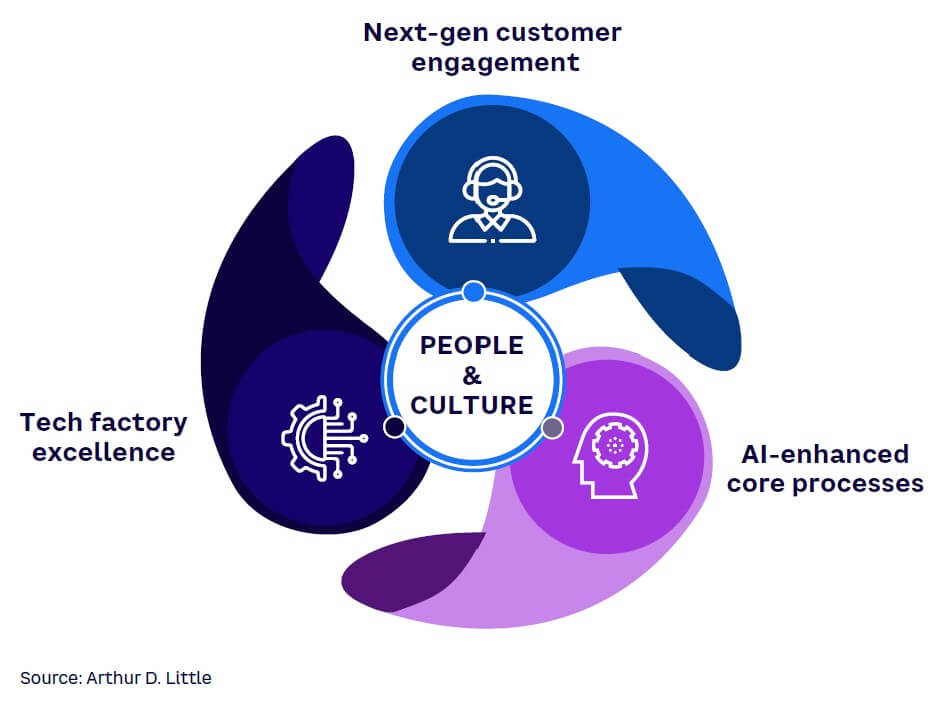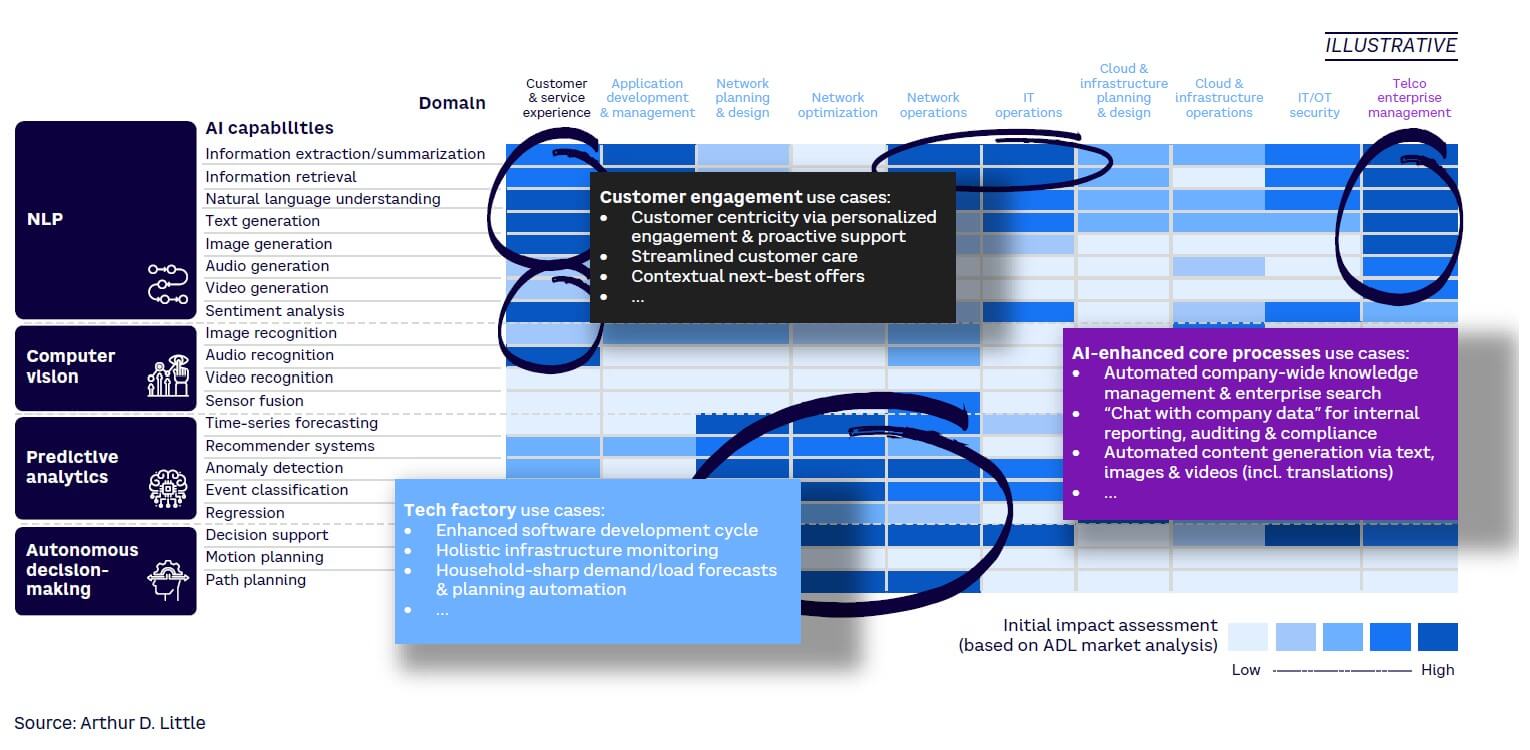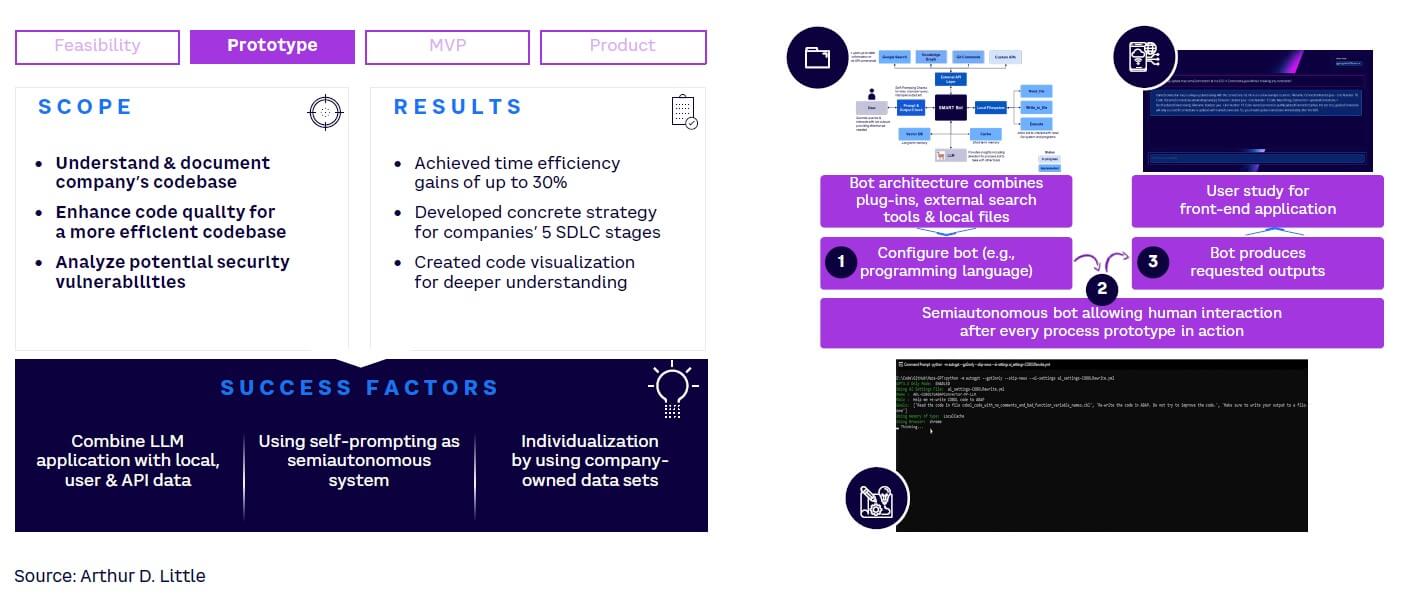
DOWNLOAD
DATE
Contact
AI represents a game changer for the telco industry. Although first movers have already embraced AI, separating hype from opportunity remains challenging. Becoming an AI-amplified telco calls for more than being fascinated by the technology’s potential and piloting use cases. This Viewpoint focuses on the necessary building blocks to exploit AI’s 5%-7% EBITDA potential and outlines how to achieve lasting success by analyzing the full picture, including technology, AI governance, and culture.
NAVIGATING THE AI HYPE
How can AI help companies shift from differentiating based on “gigabytes per customer” to delivering the highest-quality network experience and leading technical services while offering unrivaled customer support? AI opens a wealth of new possibilities for telcos, but deciding where to start can be complex.
AI can enhance typical company support processes like finance, HR, and knowledge management, but the technology has far deeper and wider applications. This Viewpoint builds on the definitions contained in Arthur D. Little’s (ADL’s) Blue Shift Report “Generative Artificial Intelligence: Toward a New Civilization?” by identifying three main building blocks (see Figure 1) that offer the most promising opportunities to deliver enormous quality improvements, cost reductions, and/or revenue growth: (1) next-gen customer engagement, (2) tech factory excellence, and (3) AI-enhanced core processes. Involving people and fostering the required governance foundation are key success factors that underpin the building blocks. Without adoption by humans, the best AI will simply not achieve its intended goals.

MAPPING AI CAPABILITIES TO BUSINESS
Today’s AI capabilities fit into four general clusters:
-
Natural language processing (NLP) merges with generative AI (GenAI) to activate a conversation-driven approach to interacting with data and to generate text, images, and videos.
-
Computer vision extracts meaningful information from digital images, videos, and other visual inputs.
-
Predictive analytics cover forecasting algorithms from both machine learning (ML) and statistical models.
-
Autonomous decision-making focuses on finding optimal solutions within scenarios with partly contradictory goals.
To maximize the impact within telcos, technology clusters need to be applied to the business domains where they will deliver the strongest results (see Figure 2). While this Viewpoint considers technical maturity and market-relevant examples, it doesn’t aim to provide a comprehensive market overview. Instead, it highlights current use case trends and analyzes their EBITDA impact.

GROWTH PERSPECTIVES IN AI-AMPLIFIED TELCO
Based on analysis and market conversations, ADL believes telcos can potentially increase their annual EBITDA margins by 5%-7% between now and 2027 by integrating AI into the three building blocks of next-gen customer engagement, tech factory excellence, and AI-enhanced core processes. The EBITDA increase comprises two areas:
-
Short-term effects — created by delivering a more targeted customer offering, marketing, and individualized customer service; content creation will result in a 4%-5% EBITDA increase, driven by higher sales effectiveness and lower customer acquisition and handling costs.
-
Operational efficiency — within the network, IT, and core processes, particularly energy savings and development costs; delivers bottom-line effects of up to 1%-2% with the following key drivers:
-
Cost reductions from more efficient energy and network management
-
Better productivity in software development
Although AI plays a substantial role, successful outcomes rely on people. The workforce must fully harness AI’s inherent potential to achieve top- and bottom-line effects, which are subject to AI adoption and integration. A close examination of the three building blocks illustrates how AI can be adapted and incorporated to address a range of needs and purposes.
Next-gen customer engagement
Becoming customer-centric is an increasing differentiator for telcos. AI implementation will streamline tasks and reduce waiting times, inaccurate solution efforts, and suboptimal product recommendations. Removing traditional sources of customer dissatisfaction and reducing churn will ultimately boost sales. There are multiple ways AI can elevate current customer engagement tasks:
-
Marketing. When fully integrated and given ample data, AI will transform the telco sales operating model from product-focused to customer-centric. For example, a major European mobile network operator created a comprehensive customer data pool by utilizing real-time behavior and transactional data. Then ML algorithms were applied to deliver personalized, automated offers across all channels as part of an end-to-end recommendation system, which ultimately delivered a 6% increase in sales.
-
Sales. AI-enhanced sales strategies will transform both business-to-business (B2B) and business-to-consumer (B2C) sales. In particular, AI will improve cross-selling opportunities in the B2C market via predictive analytics that leverage vast data sets to identify customer preferences and behavior. To better compete in the B2B space, telcos can utilize price-optimization algorithms to ensure competitive and strategic pricing that maximizes revenue. AI’s pattern-recognition capabilities will identify the most promising leads, benefiting lead scoring and qualification processes.
-
Customer care. AI’s potential extends beyond initial deployments of chatbots and virtual agents to boost internal operations as well as customer-facing processes. Through voice recognition, text-to-speech, and big data analytics, customers will benefit from personalized customer engagement, with telcos matching time, tone, style, and channel to their individual needs to deliver a natural, human-like conversational experience. AI will also be able to put forth next-best offers based on data analytics; one global operator has already seen a >90% intent recognition around next-best offers in a South American implementation. Overall, AI will speed up customer queries, lowering churn by an estimated 3%-7% and reducing service costs by 2%-5%.
Using AI to understand customer intent can increase efficiency and effectiveness. Interactions can be transferred to the best-available human agent who will be empowered through real-time knowledge management and chat assistance. This type of project contributed to a 50% cost reduction per interaction and a 20% increase in customer satisfaction for a large European operator. However, telcos need to add rule-based approaches, such as knowledge graphs, to provide targeted filtering to minimize the risk of AI hallucinations, especially with contracts.
Tech factory excellence
In addition to customer-facing engagement, AI enables telcos to transform their technical operations across their network and refine software development:
-
Network planning and optimization. Telcos face a range of challenges to successfully plan and optimize their networks, from complex systems to improper resource utilization and ever-increasing bandwidth requirements. AI analysis and management dramatically improve traffic routing and workload balancing across different infrastructures and assets, which reduces costs and maximizes quality.
-
Preventing network faults and outages. Keeping networks up and running is still the highest priority for telcos. ML models help predict likely causes of potential faults by analyzing data from network sensors, identifying any problems before they occur and enabling preventive maintenance to prevent outages.
-
Enhancing software development. In the rapidly evolving technology landscape, software engineering is more important than ever. AI-driven technologies are delivering a refined software development lifecycle across four key stages:
-
Initial planning and conception. Large volumes of unstructured data (e.g., user feedback, market trends, system logs) are analyzed using NLP, providing insights that guide product planning and architectural design. Large language models (LLMs) can use data to create user personas and take on specific roles (e.g., architects, engineers, and product managers). Multi-agent frameworks like MetaGPT simulate collaborative planning and conception work, leading to a significant boost in the ramp-up of software development.
-
Coding and testing. GenAI can act as a “copilot,” drafting initial code, rapidly searching for coding solutions, and serving as an easily navigable knowledge base. This leads to faster development cycles, both for new applications and legacy application maintenance (see Figure 3). AI algorithms can also automate functional and performance testing, which generates test cases and test data and ensures higher-quality and faster delivery.
-
Migration. AI aids legacy architecture migration to more standardized commercial-off-the-shelf applications or cloud platforms through code-translation support or testing automation.
-
No operations (NoOps). IT operations can be heavily automated by integrating AI into monitoring and incident management. While the ideal state of NoOps may never be fully achieved, AI-driven operations come very close by predicting potential issues and triggering first-level automated procedures to prevent system failures.
-
Infrastructure maintenance. Maintaining and servicing their infrastructure is a major expense for telcos. While approaches such as predictive maintenance and infrastructure monitoring are mature, recent developments in AI are transforming these methodologies in two areas:
-
High uptime. AI-driven anomaly detection and event classification give a deeper granular analysis to pinpoint the root cause of network degradation. This can occur across multiple points in the network — access, transmission network, or core components — and can also specify the nature of the problem, such as interference, congestion, or high load. When combined with new approaches to decision support, the automated prioritization of tasks can create the ability to reduce incidents.
-
Contextualized insights. GenAI serves as a new entry point for browsing and interacting with the aggregated data typically stored in siloed data sources. This facilitates user access and helps them contextualize information. Users can personalize the technical depth of what they see based on their experience or current needs, leading to faster adoption.
These two factors give rise to a new, more holistic approach to infrastructure monitoring that reduces network downtime by up to 30% and minimizes wasted resources, resulting in higher customer satisfaction and lower operating costs.

AI-enhanced core processes
GenAI and NLP have broad application possibilities beyond text generation, expanding across a wide range of telco business processes. These capabilities bring transformative benefits to multiple departments by radically simplifying and automating them:
-
Finance. Telco finance departments can leverage AI to make data-driven decisions, optimize resource allocation, streamline processes, and minimize financial risks. AI can provide accurate real-time insights into revenue trends and cost patterns via predictive analytics while automating routine tasks (e.g., invoice processing and financial reporting), can reduce manual errors, and increase operational efficiency. AI-driven fraud-detection systems will strengthen security measures and mitigate risk by identifying and preventing fraudulent activities.
-
HR. AI can streamline recruitment for HR departments, foster a more efficient and employee-centric environment, simplify work-intensive tasks, enhance talent acquisition, and improve employee retention. Predictive analytics can help forecast workforce needs to allow proactive talent planning and strategic hiring. Additional time savings can be achieved through AI-driven performance management tools that offer objective insights into employee productivity, facilitating fair, data-driven performance evaluations. Moreover, AI can help identify patterns related to employee turnover and support the implementation of proactive retention strategies.
-
Procurement. By incorporating AI, procurement teams can reduce costs via automation, which improves forecasting and inventory management. Routine tasks such as order processing, vendor selection, and inventory management can be automated while analyzing historical procurement data helps predict future demand and better inform decision-making. Moving forward, AI will improve vendor risk management by assessing supplier performance, monitoring market trends, and identifying potential disruptions.
-
Legal. AI will drive a paradigm shift in manual labor–intensive work within telco legal departments by fostering efficiency, mitigating risk, and ensuring compliance. NLP capabilities enable AI to rapidly sift through vast amounts of legal documents, contracts, and regulatory information. Legal teams will manage contracts and expedite negotiations by using ML algorithms to identify key terms and potential risks and suggest improvements. Thanks to advances in AI-driven predictive analytics, legal professionals will be better able to anticipate potential legal challenges and regulatory changes and undertake proactive compliance measures.
-
Knowledge management. Knowledge management has traditionally suffered from two problems. First, gathering information is challenging because the relevance of potential sources is not easily discernable. Second, underdeveloped categorization strategies make it harder to seamlessly locate pertinent information when it is needed. Figure 4 shows how AI transforms the discipline. It overcomes information silos by consolidating data from different systems, providing employees with simplified access to up-to-date, relevant knowledge. It also enhances search capabilities by aligning results with user intents, enabling the future identification of knowledge gaps and triggering predefined resolution processes. By delivering specific responses, AI addresses compliance challenges (e.g., environmental, social, and governance reporting). Overall, it streamlines content generation, allowing operators to automate the steps and freeing employees to focus on insights rather than the mechanics of content creation.

GETTING STARTED IN BROWNFIELD REALITY
Most telcos are established and often complex organizations, with large-scale IT and network infrastructures. This means companies need to apply AI to a brownfield reality, without the advantage of beginning from a blank sheet of paper (i.e., new software/systems must consider and coexist with software/systems already in place). As AI initiatives are developed and implemented, it is crucial to address two existing elements from the outset. Data, the underlying raw material for AI, is typically located in legacy systems not designed for AI use, while people and culture may not immediately be open to the transformative possibilities of new technology.
Human-centered AI as a cultural success factor
People and culture are at the heart of the three building blocks of the AI-amplified telco. Involving people in the integration and development of AI is crucial; employee buy-in and management education are core aspects of cultural changes that will support AI. As deployments progress, there are necessary steps to make AI tangible for non-experts.
Tangibility in daily use increases interest and promotes discussions on understanding the technology, which increases adoption. Therefore, three factors should guide strategy and implementation:
-
Put people at the center of the AI journey. It is essential to prioritize the needs and challenges of individuals for successful AI integration. The important role humans play in the translation of business requirements into technology is even more important than in typical IT projects due to the necessary retranslation of how AI, with its algorithm-dependent problem-solving approach, will meet a requirement. The resulting negotiation process should strengthen the company’s understanding of AI while increasing its adoption and boosting collaboration between technical and business teams.
-
AI does not exist in silos. Effective AI solutions result from collaboration between business, IT, and delivery teams. To deliver a high-quality project, organizations need to form multidisciplinary teams with representatives from different fields to align their common goals and then design and implement AI solutions. This approach also maximizes insight sharing, best practices, and new learning across the company, benefiting overall adoption.
-
Strategy and business-driven implementation go hand in hand. To succeed, it is essential to understand the interaction between strategy and implementation. AI needs a constant iteration of strategy based on insights from delivery. Strategic AI plans must therefore be reviewed regularly, as the technology is still highly dynamic, so new strategic deployment opportunities should be expected.
Adopting change management processes from the start is key to driving superior, human-centered AI; these include creating open communications channels for employees to voice their concerns, sharing information to dispel common misconceptions, and sharing feedback on AI implementations. Employees should have opportunities to participate and offer feedback, in particular during the design and testing phases, to ensure that AI tools meet their real-world requirements. After going live, offering training programs to help employees acquire the skills needed to work effectively with AI technologies is essential to close the feedback loop and uncover new features for future development.
A technical perspective on scaling portfolios & projects
Moving from a proof of concept to an operational IT product is one of the biggest challenges to widespread technology adoption. AI projects often stall due to scaling issues (e.g., building without clear architecture or on different platforms), leading to a down phase. To prevent this outcome, it is essential to put in place the right technology setup to underpin each project maturity stage, based on both AI itself and the reality of operating in a brownfield environment. Three enablers help overcome roadblocks:
-
Platforms first. As fundamental frameworks, platforms are a structured environment for deploying, managing, and scaling AI solutions. To thrive in a brownfield environment, it is essential to identify and launch AI development platforms that provide comprehensive tools and services to ease the creation, deployment, and monitoring of models in their first phases and later aid productization and operation. Centralized platforms must also enable collaboration between data scientists, developers, and subject matter experts, especially for assessing evaluation and testing. This speeds up the development and value creation of AI solutions. Implementing infrastructure-as-code practices to automate the provisioning and scaling of AI resources can also help goal attainment.
-
Combining market services with open source. By allowing access to a wide range of tools and resources, open source technologies can speed up development, which is a key challenge to organizations. Open source technologies reduce short-term costs by delivering solutions not yet offered by common cloud providers. However, over the long term, open source operational costs should be carefully managed, as proprietary solutions may become more cost-effective as they mature.
-
Ensuring data availability. The availability of sufficient, high-quality data is another crucial roadblock to scaling AI solutions. Mitigating this requires organizations to implement stringent data management practices to verify that data is accurate, complete, and up to date while using careful AI algorithm selection and feature engineering to reduce the need for data volumes and therefore bring down costs. These best practices should be shared across the organization via data governance to maximize their value.
AI governance
Adopting these technical enablers helps underpin a value-creating, sustainable, and growing AI portfolio. However, success is not only dependent on meeting technical needs; strong management is required to establish data and AI governance across the organization, including through these three critical points:
-
Standard operating procedures (SOPs). Standardization relies on the establishment and enforcement of consistent processes and policies for AI’s development, deployment, maintenance, and operations. SOPs streamline workflows and ensure quality, reliability, and compliance. Within a brownfield situation, it is essential to initiate and document standardized procedures for data acquisition, preprocessing, model training, and evaluation. Regularly updating and refining those SOPs based on lessons learned and best practices solidifies their continued relevance to the organization.
-
Linking data management and AI governance. AI cannot be effective without good data. Therefore, AI governance must create a clear framework to link to data strategies and initiatives — or, ideally, to bring data and AI initiatives together organizationally. This connection not only boosts initiatives but also increases the practical relevance of data management by directly linking it to implementation projects for data use.
-
Meet the EU AI Act through test-driven safety. The recently agreed-upon EU AI Act provides a regulatory framework for AI applications in Europe and adds a further layer to AI governance. The AI Act goes beyond ethical frameworks, requiring risk management based on organizing AI models into risk classes. It makes a clear legal distinction between AI (especially general-purpose models) and regular software. This regulation must be factored into governance considerations around needs for future system certification.
Conclusion
SUCCESSFULLY CREATING THE AI-AMPLIFIED TELCO
AI is already demonstrating the potential for significant financial, organizational, and operational benefits. A sharp focus on the three building blocks of next-gen customer engagement, tech factory excellence, and AI-enhanced core processes will drive this potential. To succeed, telcos need to:
-
Overcome technological, human, data, and strategy-related challenges — through stringent, but not purely centralized, AI governance by adopting pragmatic development practices and focusing on the human aspect.
-
Prioritize clear business needs and impacts to ensure relevance — via a structured model with deliberate maturity phases acting as stage gates for projects.
-
Embrace nonlinear development — requiring experimentation, adaptation, and the acceptance of uncertainty. In a brownfield environment, this culture of experimentation will remove roadblocks and drive progress.







